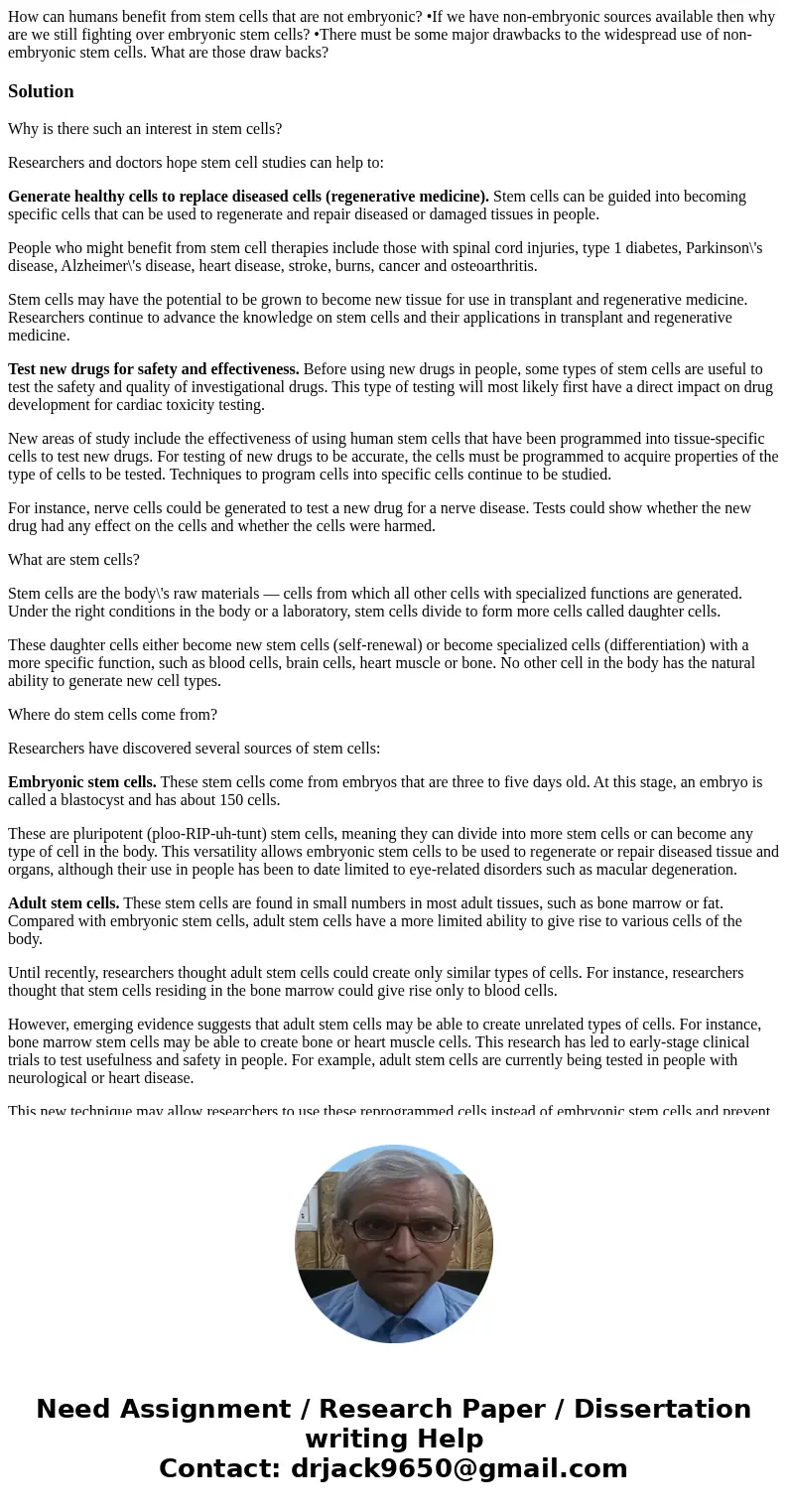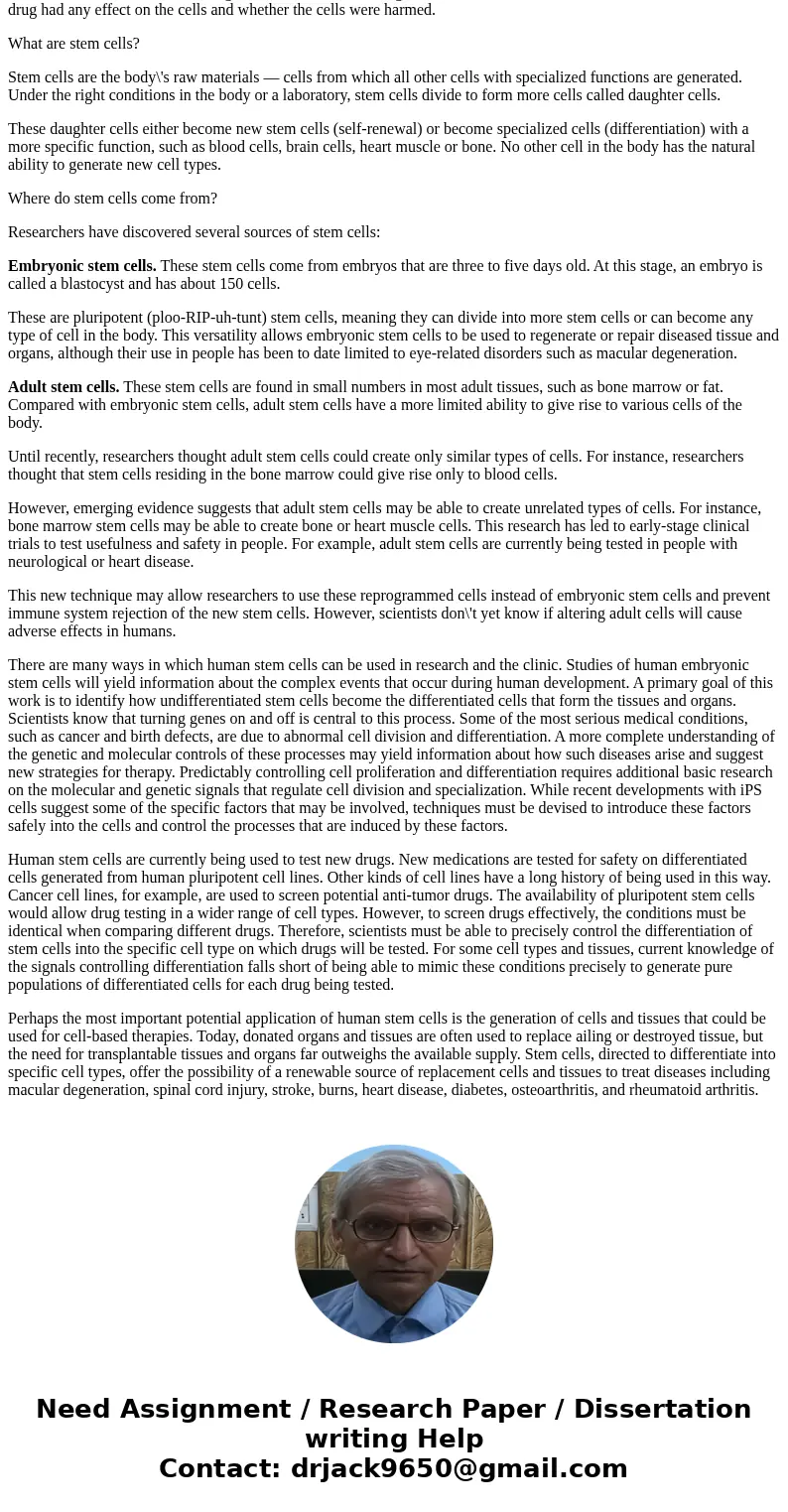How can humans benefit from stem cells that are not embryoni
How can humans benefit from stem cells that are not embryonic? •If we have non-embryonic sources available then why are we still fighting over embryonic stem cells? •There must be some major drawbacks to the widespread use of non-embryonic stem cells. What are those draw backs?
Solution
Why is there such an interest in stem cells?
Researchers and doctors hope stem cell studies can help to:
Generate healthy cells to replace diseased cells (regenerative medicine). Stem cells can be guided into becoming specific cells that can be used to regenerate and repair diseased or damaged tissues in people.
People who might benefit from stem cell therapies include those with spinal cord injuries, type 1 diabetes, Parkinson\'s disease, Alzheimer\'s disease, heart disease, stroke, burns, cancer and osteoarthritis.
Stem cells may have the potential to be grown to become new tissue for use in transplant and regenerative medicine. Researchers continue to advance the knowledge on stem cells and their applications in transplant and regenerative medicine.
Test new drugs for safety and effectiveness. Before using new drugs in people, some types of stem cells are useful to test the safety and quality of investigational drugs. This type of testing will most likely first have a direct impact on drug development for cardiac toxicity testing.
New areas of study include the effectiveness of using human stem cells that have been programmed into tissue-specific cells to test new drugs. For testing of new drugs to be accurate, the cells must be programmed to acquire properties of the type of cells to be tested. Techniques to program cells into specific cells continue to be studied.
For instance, nerve cells could be generated to test a new drug for a nerve disease. Tests could show whether the new drug had any effect on the cells and whether the cells were harmed.
What are stem cells?
Stem cells are the body\'s raw materials — cells from which all other cells with specialized functions are generated. Under the right conditions in the body or a laboratory, stem cells divide to form more cells called daughter cells.
These daughter cells either become new stem cells (self-renewal) or become specialized cells (differentiation) with a more specific function, such as blood cells, brain cells, heart muscle or bone. No other cell in the body has the natural ability to generate new cell types.
Where do stem cells come from?
Researchers have discovered several sources of stem cells:
Embryonic stem cells. These stem cells come from embryos that are three to five days old. At this stage, an embryo is called a blastocyst and has about 150 cells.
These are pluripotent (ploo-RIP-uh-tunt) stem cells, meaning they can divide into more stem cells or can become any type of cell in the body. This versatility allows embryonic stem cells to be used to regenerate or repair diseased tissue and organs, although their use in people has been to date limited to eye-related disorders such as macular degeneration.
Adult stem cells. These stem cells are found in small numbers in most adult tissues, such as bone marrow or fat. Compared with embryonic stem cells, adult stem cells have a more limited ability to give rise to various cells of the body.
Until recently, researchers thought adult stem cells could create only similar types of cells. For instance, researchers thought that stem cells residing in the bone marrow could give rise only to blood cells.
However, emerging evidence suggests that adult stem cells may be able to create unrelated types of cells. For instance, bone marrow stem cells may be able to create bone or heart muscle cells. This research has led to early-stage clinical trials to test usefulness and safety in people. For example, adult stem cells are currently being tested in people with neurological or heart disease.
This new technique may allow researchers to use these reprogrammed cells instead of embryonic stem cells and prevent immune system rejection of the new stem cells. However, scientists don\'t yet know if altering adult cells will cause adverse effects in humans.
There are many ways in which human stem cells can be used in research and the clinic. Studies of human embryonic stem cells will yield information about the complex events that occur during human development. A primary goal of this work is to identify how undifferentiated stem cells become the differentiated cells that form the tissues and organs. Scientists know that turning genes on and off is central to this process. Some of the most serious medical conditions, such as cancer and birth defects, are due to abnormal cell division and differentiation. A more complete understanding of the genetic and molecular controls of these processes may yield information about how such diseases arise and suggest new strategies for therapy. Predictably controlling cell proliferation and differentiation requires additional basic research on the molecular and genetic signals that regulate cell division and specialization. While recent developments with iPS cells suggest some of the specific factors that may be involved, techniques must be devised to introduce these factors safely into the cells and control the processes that are induced by these factors.
Human stem cells are currently being used to test new drugs. New medications are tested for safety on differentiated cells generated from human pluripotent cell lines. Other kinds of cell lines have a long history of being used in this way. Cancer cell lines, for example, are used to screen potential anti-tumor drugs. The availability of pluripotent stem cells would allow drug testing in a wider range of cell types. However, to screen drugs effectively, the conditions must be identical when comparing different drugs. Therefore, scientists must be able to precisely control the differentiation of stem cells into the specific cell type on which drugs will be tested. For some cell types and tissues, current knowledge of the signals controlling differentiation falls short of being able to mimic these conditions precisely to generate pure populations of differentiated cells for each drug being tested.
Perhaps the most important potential application of human stem cells is the generation of cells and tissues that could be used for cell-based therapies. Today, donated organs and tissues are often used to replace ailing or destroyed tissue, but the need for transplantable tissues and organs far outweighs the available supply. Stem cells, directed to differentiate into specific cell types, offer the possibility of a renewable source of replacement cells and tissues to treat diseases including macular degeneration, spinal cord injury, stroke, burns, heart disease, diabetes, osteoarthritis, and rheumatoid arthritis.


 Homework Sourse
Homework Sourse